Introduction
Scientists and land managers are increasingly aware of the ecosystem services provided by urban forests and soils. Nonetheless, urban soils remain poorly understood. Agriculture and forest soils are frequently studied whereas urban soil are frequently assumed to be homogenous, heavily disturbed, or of low fertility. Most soil survey maps in fact do not even describe urban soils, delineating them instead as blank areas on the landscape. Recent studies are however showing that urban soils are highly variable, ranging from highly modified to relatively undisturbed (Dobbs 2009). Despite this variability, certain trends and patterns in soil characteristics are being observed across urbanized landscapes (Pouyat et al. 2007). To sustainable management urban areas, professional and the public need an improved understanding of how and why soil properties vary across an urban and urbanizing landscape (Hagan et al. 2010 and 2012).
Recent studies being conducted in Tampa are an example of how soils are affected by the process of urbanization. It is the second-most populous urban area in Florida (2.7 million residents), and has numerous older developed urban areas as well as other areas in various states of urban and suburban development. In this publication, we used geostatistics (a type of statistics that uses spatial data) and Geographical Information Systems to map and provide an overview of four key soil properties in Tampa—bulk density, phosphorus, lead, and organic matter content—and explain how they vary across different land uses. These soil properties are of importance for plant growth, stormwater runoff, and for planning purposes. Surface soils from the upper 10 cm, collected from 106 locations across Tampa, were used for this analysis. Samples were analyzed at the University of Florida's Analytical Services Laboratory. While this is a relatively small sample size (due to budget and time constraints), this same approach has been used elsewhere (Hagan et al. 2012; Pouyat et al. 2007) and can provide important information on urban soil properties that can be used to supplement information from soil surveys. This information should be of use to land-use planners, water management districts, extension agents, and municipalities.
Physical and Chemical Properties of Urban Soils
Bulk Density
Soil bulk density (mass of soil per unit volume), is a measure of soil compaction, is a soil physical property that has important implications for plant growth, water infiltration, stormwater runoff, and erodibility. Increased soil bulk density is often a prerequisite for building stability, and reduces building subsidence. Additionally, urban activities that disturb the soil, such as foot and vehicle traffic, as well as building and roadway construction, result in an increase in bulk density. The presence of soil organic matter, which is often depleted in urbanized areas, can also help decrease bulk density. Heavily urbanized areas, therefore, typically have bulk densities that are greater than natural areas such as forests and wetlands. Vegetation cover, however, is not necessarily a good predictor of bulk density, as urban soils covered in turfgrass are among the most compacted (Hagan et al. 2010 and 2012).
Soil bulk density in Tampa averaged 1.02 g/cm3, which is considerably lower than values reported from other cities in Florida and 1.3 g/cm3 which is considered ideal for most purposes. Reported values were highly variable ranging from 0.59 g/cm3 (very low) to 1.33 g/cm3 (about average). In general, bulk density is highest in institutional, residential, vacant, and wetland areas, where values approaching and exceeding 1.1 g/cm3 are common. Soils in highly developed areas southwest of downtown Tampa are also more compacted than surrounding areas, exceeding 1.0 g/cm3 across a large area. The least compacted soils (BD = 1.0 g/cm3) are in industrial land uses and in suburban and agricultural areas (Figures 1a and 1b).
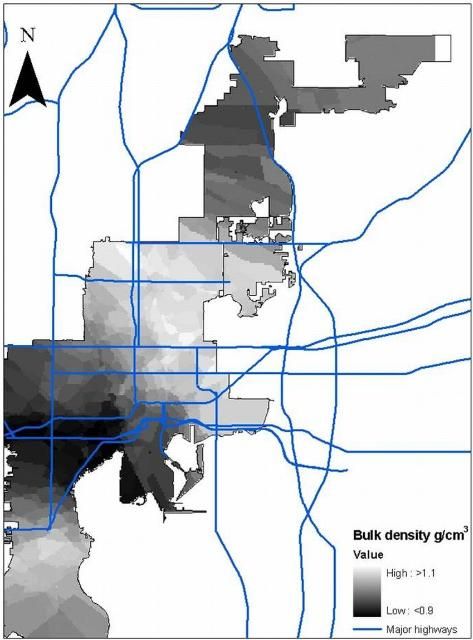
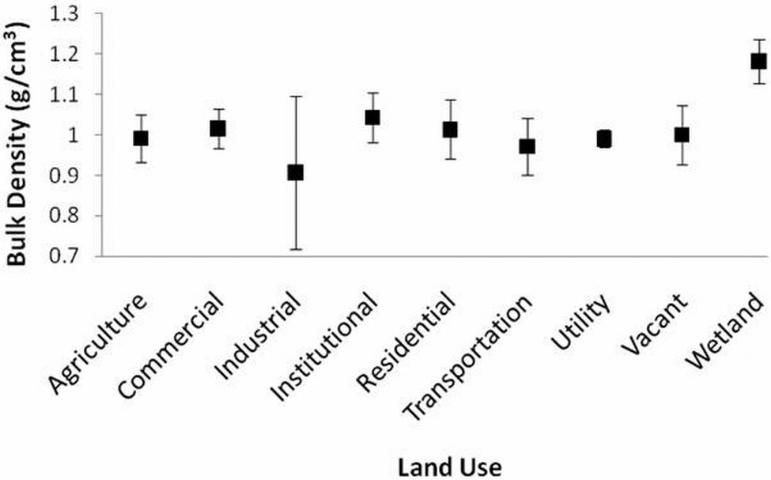
Phosphorus
Phosphorus is an essential plant nutrient that is found naturally, in varying concentrations, in most soils that tends to accumulate over time. In general, "young" urban soils - especially those consisting of sandy fill material - are often phosphorus depleted, while soils in older urbanizations are more likely to be phosphorus enriched. This generally occurs in urban soils that have undergone fertilization or are the recipients of phosphorus containing wastes (e.g. septic tanks and leaks from sewer lines). To maintain urban soil and water quality, soil phosphorus is an important consideration, as phosphorus leached from urban soils is a primary cause of surface (freshwater) and groundwater contamination in Florida. Since most Florida soils have a limited ability to retain phosphorus, the application of fertilizers and wastes should always be done judiciously and only after appropriate soil tests have been conducted.
Soil phosphorus concentrations across Tampa are highly variable, averaging 89.89 mg/kg and ranging from 0.67 to 1094.80 mg/kg. According to the Florida Phosphorus index, all soils in Tampa classified by the USDA as "urban" have very high potential for phosphorus runoff, while runoff potentials for lesser developed areas range from low to very high. Phosphorus leaching potential ranges from very low to very high. Differences in runoff and leaching are due to the presence or absence of impervious surfaces and near surface parent materials, which inhibit infiltration, and loamy or clayey layers, which bind phosphorus and inhibit leaching. The spike in soil phosphorus around highly urbanized commercial and residential areas near downtown Tampa, where concentrations exceed 200 mg/kg, could be either geological or anthropogenic in nature. Soils in this area likely have a greater ability to retain applied phosphorus, but the predominance of impervious surfaces in this area creates a high risk of loss via surface runoff (Figures 2a and 2b).
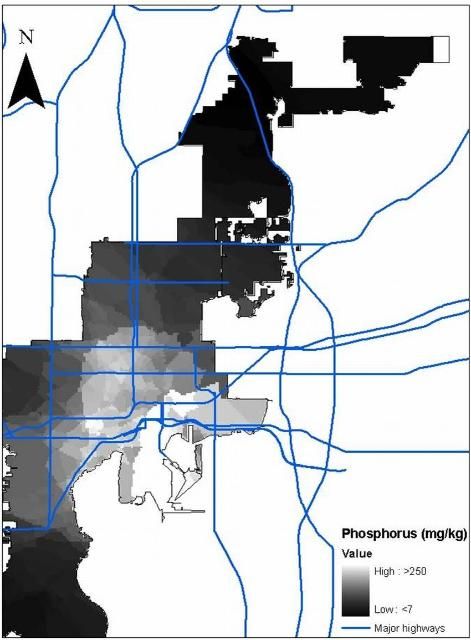
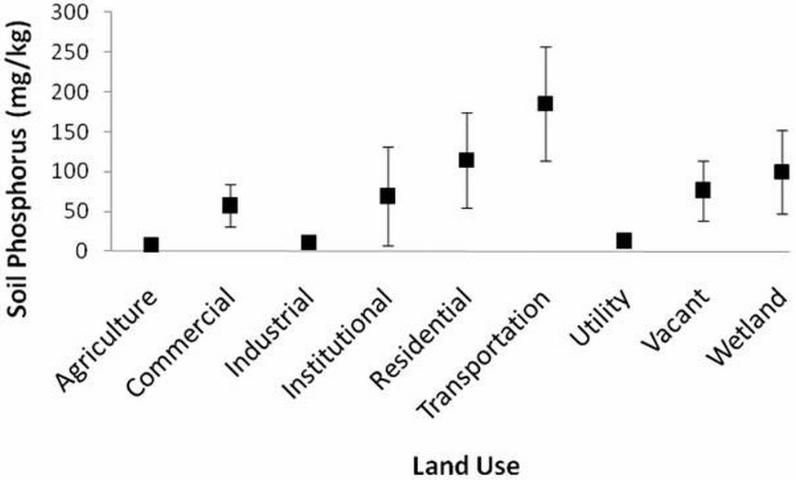
Organic Matter
Soil organic matter is the decomposed and/or partially decomposed remnants of living organisms (primarily plants) found in soils and is a storehouse for plant nutrients like nitrogen. As such, soil organic matter has important implications for plant growth. Its light, porous nature helps increase soil water retention capacity, promote proper soil structure, and decrease bulk density. Soil organic matter also increases a soil's ability to retain contaminants, thereby decreasing the likelihood of offsite contamination. The accumulation of soil organic matter, which is approximately 50% carbon, is a process that captures and stores atmospheric CO2, thereby helping to mitigate climate change. Since it is primarily of plant origin, it tends to accumulate in urban or forest areas with tree or grass cover, or poorly drained areas like wetlands where decomposition is inhibited.
Soil organic matter in Tampa averages 4.8% of total soil weight. Like other soil properties, however, it is highly variable, with a range of 0.9% to 13.2%. Most areas in Tampa with low bulk density (e.g., high density commercial, industrial, and residential areas) roughly correspond to areas with the highest organic matter content, and vice versa. The lowest organic matter contents are in suburban areas in north and northeastern Tampa. Intermediate values for soil organic matter are generally found outside of the highly developed urban core (Figures 3a and 3b).

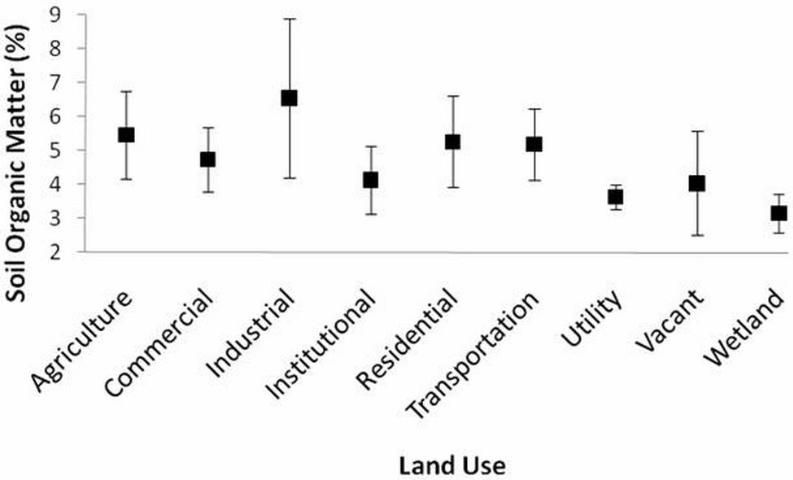
Lead
Lead is a heavy metal that occurs naturally, usually in low concentrations, in many soils. In urban areas, however, elevated lead concentrations are common and are primarily attributable to industrial emissions and past use of lead in gasoline, paint, and pipes (Chirenje et al. 2004). Lead is not very mobile in soil, and thus tends to accumulate over time rather than leach. Lead contamination is a major cause for concern, as it has been linked to behavioral problems, learning disabilities, seizures, and death. Young children are particularly at risk, as they are most likely to come in contact with or ingest lead contaminated soils. The US Environmental Protection Agency has established lead clean-up target levels of 400 and 920 mg/kg for residential and commercial areas, respectively (www.epa.gov/lead).
Soil lead concentrations in Tampa averaged 55.81 mg/kg, and range from 11.48 to 943.2 mg/g. The highest values, which approach and exceed EPA clean-up target levels, are found in localized areas near downtown, which is an older and highly developed commercial, industrial, and residential zone. Vacant land in this area has, by far, the highest soil lead concentrations in Tampa. The lower concentrations found elsewhere in the city are of minimal concern, since it is unlikely that much additional lead will accumulate in these areas (Figures 4a and 4b).
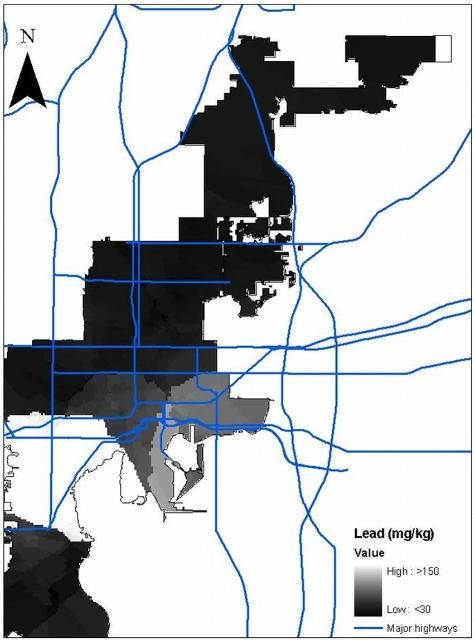
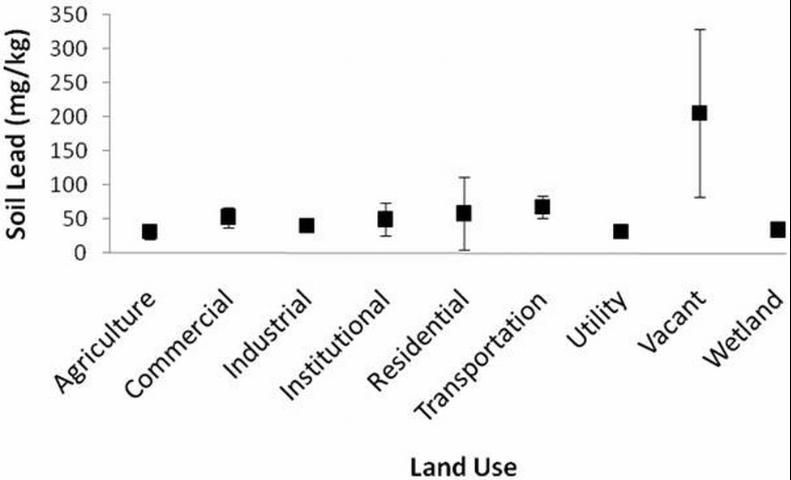
Conclusion
Urban soils, as indicated by our soil bulk density, phosphorus, organic matter, and lead measurements, are highly variable across Tampa's urban and urbanizing landscape. This suggests that Tampa's urban soils are diverse, complex, and affected by numerous human and environmental factors (Dobbs 2009). Improving our understanding of these factors is an essential first step in interpreting soil surveys, urban land use planning, decision making, predicting the effects of climate change, and the sustainable management of the urban soil resource.
References
Chirenje T, Ma LQ, Reeves M and Szulczewski M. 2004. Lead distribution in near-surface soils of two Florida cities: Gainesville and Miami. Geoderma 119(1-2):113–120.
Dobbs, C. 2009. An Index of Gainesville's Urban Forest Ecosystem Services and Goods. University of Florida MS Thesis.
Hagan, D.L., Dobbs, C, and Escobedo, F. 2010. Florida's urban soils: Underfoot yet overlooked. Gainesville: University of Florida Institute of Food and Agricultural Sciences.
Hagan, D., Dobbs, C., Timilsina, N., Escobedo, F., Toor, G., Andreu, M. 2012. Anthropogenic effects on the physical and chemical properties of subtropical coastal urban soils. Soil Use and Management, 28: 78–88.
Hurt, G.W., Mylavarapu, R.S., and Boetger, S.P. 2006. UF/IFAS Nutrient Management Series: Computational Tools for Field Implementation of the Florida Phosphorus Index – Hillsborough County Florida. Circular 1316. Gainesville: University of Florida Institute of Food and Agricultural Sciences.